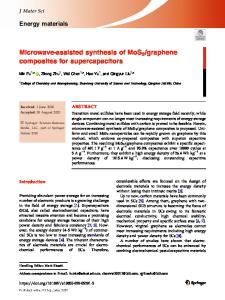Laser - Assisted Synthesis of Unique Graded Surface Composites
- PDF / 3,516,298 Bytes
- 6 Pages / 414.72 x 648 pts Page_size
- 110 Downloads / 515 Views
Composite -C
Surface Composite
.5S
Cross-Section:.
4.
4
..
C
Top View
(a)
(b)
(c)
Figure I Schematic diagram showing the cross-section and top view of various engineered materials (a) bulk composite (b) functionally graded materials and (c) surface composite.
567 Mat. Res. Soc. Symp. Proc. Vol. 397 01996 Materials Research Society
To develop useful bulk composite microstructure, the reinforcement phase should be uniformly dispersed and should possess chemical, thermal and interfacial compatibility with the matrix. In FGM, the chemical composition is varied either continuously or discontinuously across the thickness so that the properties can be gradually altered [1]. An example for application of FGM is thermally mismatched coatings where the high thermal and residual stresses lead to debonding, delamination, or surface cracking of the coating. One effective way of reducing residual and thermal stresses and enhancing bonding strength is to create a FGM which eliminates material properties discontinuities by grading the material composition near the interface or through the coating. The gradients can be continuous on a microscopic level or they can be in the form of laminates comprised of gradients of metals, ceramics or polymers or variations in porosity and density [2]. The graded composition in FGMs is created either by powder processing methods or by changing the composition during co-deposition of single layer or alternate layer coatings. In this paper, we describe a new class of engineered materials called surface composites in which the stresses due to thermal mismatch of the two materials are linearly graded near the surface regions. A schematic diagram depicting the cross-section and top view of a surface composite structure is shown in Figure 1(c). Surface composites are very different from existing engineered materials such as "bulk composites" and "functionally graded materials" (FGM). Unlike bulk composites, the second dispersed phase in surface composites is present only at the near surface regions. In contrast to FGM, the graded properties in surface composites are achieved by unique morphological surface modification of the bulk phase. Thus, as the top view shows, the surface phase in surface composites is uniformly distributed in the form of clusters on the surface. Linear gradation in composition is achieved by decreasing the cluster size as a function of depth from the surface. The fabrication of surface composites is critically dependent on formation of semi-periodic, microrough structures on the surface of the bulk material (metal or ceramic). These structures are formed by using multiple pulse laser irradiation at energy densities in the vicinity of the ablation threshold, the details of which are discussed in the next section [3]. The laser induced micro-rough structures (LIMS) possess surface areas which may be more than an order of magnitude higher than the original surface. One of the most important features of surface composites is formation of a mechanically and composition
Data Loading...











